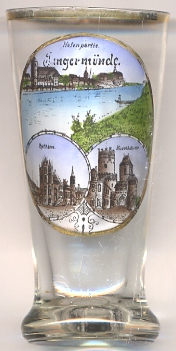

|
| DEUTSCHLAND | GERMANY |
| Bundesland: Sachsen-Anhalt | Saxony-Anhalt |
| Landkreis: Stendal |
 Tangermünde is situated at an elevation of 43 m at the edge of the Altmark region of Saxony-Anhalt,
where the river Tanger flows into the river Elbe, southeast of the district town Stendal.
Tangermünde is situated at an elevation of 43 m at the edge of the Altmark region of Saxony-Anhalt,
where the river Tanger flows into the river Elbe, southeast of the district town Stendal.
The oldest written mention of Tangermünde is found in a document of 1009; the oldest mention of the status as a town dates from 1276. Due to its location on a rock at the river bank, Tangermünde became an important customs place and a residence of the margraves of Brandenburg. In the 14th century Tangermünde temporarily was a favourite place of residence of Emperor Karl IV. Upon a resurrection of the town in 1488, Elector Johann Cicero of Brandenburg transfered his seat to Berlin. In 1617 the town was destroyed by a large fire which was blamed on the orphan Grete Minde; this inspired the famous German poet Theodor Fontane to write his novel Grete Minde. Nach einer altmärkischen Chronik, which was published first in 1880. Today, Tangermünde is well-known for its almost entirely preserved city wall with fortified gates, the castle complex and numerous historic buildings.
The  town hall of Tangermünde [left, no. 2309; and below, no. 2975: bottom left picture]
is one of the best preserved and most beautiful buildings
of the late Gothic period in Germany. The oldest part of the building, built in 1430, is the east wing with its
monumental façade (height 24 m) and the ceremonial hall. The access balcony was added in 1846 by the famous
architect Friedrich August Stüler. Underneath the town hall there is an extensive system of vaults, which, like the
town hall, was created in the 15th century.
town hall of Tangermünde [left, no. 2309; and below, no. 2975: bottom left picture]
is one of the best preserved and most beautiful buildings
of the late Gothic period in Germany. The oldest part of the building, built in 1430, is the east wing with its
monumental façade (height 24 m) and the ceremonial hall. The access balcony was added in 1846 by the famous
architect Friedrich August Stüler. Underneath the town hall there is an extensive system of vaults, which, like the
town hall, was created in the 15th century.

The  church of Sankt Stephan [near left, no. 2975: top picture: barely visible on the left]
was built starting after 1350 in place of an older, Romanesque church. The nave was completed by the vaulted roof in 1405.
Of the two west towers, the south tower remained unfinished. The new choir was begun around 1450 and was finished by 1475.
The roof of the north tower was destroyed by a large fire in 1617. A century later, in 1715, it was replaced by a new, Baroque roof.
church of Sankt Stephan [near left, no. 2975: top picture: barely visible on the left]
was built starting after 1350 in place of an older, Romanesque church. The nave was completed by the vaulted roof in 1405.
Of the two west towers, the south tower remained unfinished. The new choir was begun around 1450 and was finished by 1475.
The roof of the north tower was destroyed by a large fire in 1617. A century later, in 1715, it was replaced by a new, Baroque roof.
The  Neustädter Tor [near left, no. 2975: bottom right picture: foreground and left tower]
is a remnant of the Medieval fortifications of Tangermünde.
The entire gate originally consisted of an outer gate with an inner bailey, a stone bridge over the town's moat, and an inner gate,
flanked by two towers. What can be seen today are the rests of the outer gate. The rectangular gate tower dates from aournd 1300.
It received its tiled hipped roof in the 16th century. The round tower (27 m high) and the proper gate date from the 15th century.
Both towers are connected by a covered battlement above the thoroughfare.
Neustädter Tor [near left, no. 2975: bottom right picture: foreground and left tower]
is a remnant of the Medieval fortifications of Tangermünde.
The entire gate originally consisted of an outer gate with an inner bailey, a stone bridge over the town's moat, and an inner gate,
flanked by two towers. What can be seen today are the rests of the outer gate. The rectangular gate tower dates from aournd 1300.
It received its tiled hipped roof in the 16th century. The round tower (27 m high) and the proper gate date from the 15th century.
Both towers are connected by a covered battlement above the thoroughfare.
The  former church of St. Nicolas [near left, no. 2975: bottom right picture: background right tower]
was built around 1200. Since the 16th century, however, it was used for profane purposes.
former church of St. Nicolas [near left, no. 2975: bottom right picture: background right tower]
was built around 1200. Since the 16th century, however, it was used for profane purposes.
The bottom left picture show a view of the town hall (see above).
[https://de.wikipedia.org/wiki/Tangermünde; https://de.wikipedia.org/wiki/St._Stephanskirche_(Tangermünde);
http://www.sachsen-anhalt-wiki.de/index.php/Neustädter_Tor_(Tangermünde)]
![[scale]](lineal.jpg)